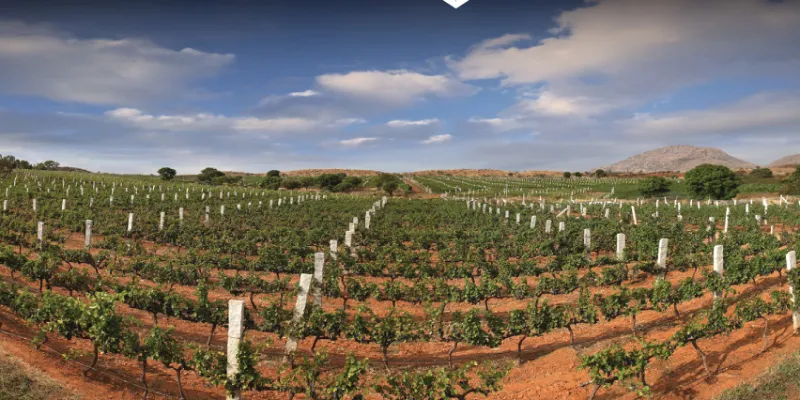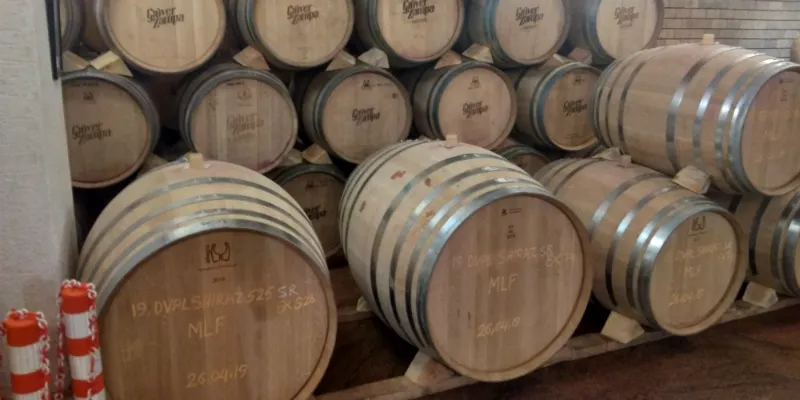From Nandi Hills to India's second largest wine company, here's the story of Grover Zampa Vineyards
Grover Zampa’s underground storage unit contains 400 barrels of wine, which are imported from France. Depending on the kind, the wine is aged for anywhere between a few months to two years.
In the early 1960s, businessman Kanwal Grover was importing French machinery and tools for India’s defence and space programmes. Each time he visited France, his passion for fine wines grew.
It took a long time to Kanwal to convert his passion into profession. In 1989, Kanwal and his business partner George Vesselle started their first vineyard at the foot of Nandi Hills, near Bengaluru. The vineyard, named after Grover, produced the first batch of vintage wine in 1992.
Today, Grover wines has cemented its legacy as the country’s leading producer and exporter of fine wine so much so that Kanwal is now referred to as the ‘father of Indian viticulture’ (wine-growing).

Grover Zampa's vineyard in Nandi Hills
In 2012, Grover wines merged with Nashik-based Vallée de Vin, following which Grover wines was named 'Grover Zampa'. The name Zampa was taken from Vallée de Vin’s Zampa range of wines.
Mergers have a corporate connotation but Grover Zampa is also a family business. Kapil Grover, Kanwal’s son, and Karishma Grover, Kanwal’s granddaughter, now lead the brand. Ravi Viswanathan, renowned wine investor, is also at the helm as Chairman, and Vivek Chandramohan oversees the brand as its CEO.
Grover Zampa is now India’s second largest overall wine-maker after Sula Vineyards, say industry sources. Last year, the company recorded a revenue of Rs 57.77 crore, making it one of the leaders in fine wine.
Grover makes red, white, sparkling, and rose wine, costing up to around Rs 2,500. Some of its premium wines include the Grover Vijay Amritraj Reserve Collection (in red and white), Zampa Grand Chene Reserve, and the Zampa L'Amour Brut Rose.

Vivek Chandramohan, CEO, Grover Zampa
But, Grover wines is not competing with Sula in volume, according to Vivek, who says:
“Our focus is on quality, which has always been the cornerstone of our endeavours. We now produce around 2.6 lakh cases of high quality wine a year.”
Behind the scenes
To ensure premium quality, Grover Zampa’s wine-making process is intricate and relies largely on machinery and barrels imported from France and Italy.
Grapes are sourced from the Nandi Hills vineyard as well as from plantations in Maharashtra and Andhra Pradesh. They are harvested between January and March.
“The grapes for red wine usually come from Solapur in Maharashtra because of its laterite soil. And the grapes for white wine come from Nashik since the soil there is loamy,” Vivek says.

Grover Zampa has 106 such fermentation tanks
He adds that Grover Zampa interacts with and works alongside farmers to boost the quality of the grapes that come in.
Once the grapes come into the Nandi Hills factory, they are passed through a set of vibrating machines which separate the grapes from dirt, stones, or other unwanted substances.
They are then passed through a unique machine that captures images of all the grapes. These images help Grover Zampa sort ripe grapes from raw or rotten bunches.
The fruit then goes into large, stainless steel tanks for pressing and fermentation. These tanks are maintained at cool temperatures as oxidation speeds up in warmer environments and degrades the wine.
There are 106 such large tanks on site, and they can each can fit up to 60 tons of grapes.
Grover Zampa also uses two ovoid-shaped (egg-shaped) and one reverse ovoid-shaped concrete containers for fermentation over 20 days.
The fermented wine is then sent to the barrel room for aging. Grover Zampa’s underground storage unit contains 400 barrels of wine, which are imported from France. Depending on the kind, the wine is aged for anywhere between a few months to two years.

Grover Zampa's barrel room currently has 400 barrels of wine and can fit up to 600
After tasting, it then goes to the bottling unit where the wine is filled into bottles and sealed with a bottle cap.
The bottles are then spun slowly on a riddling machine in order to counteract the effect of yeast on the wine.
The bottle cap is replaced with a cork, and the wine is sent for another round of aging. This time, it just sits in the bottles for up to two years. Only now does Grover Zampa sends its bottles out for sale -at least four years after the grapes first entered the factory.
The entire process is carried out by a team of local oenologists and on-site workers under the direction of international French wine consultant Michel Rolland and French winemaker Mathias Pellisard.
Vivek says, “We have around 12 people in charge of vineyards, around 60 people in sales, and numerous others on site. With these numbers, emphasis on quality, and lower profit margins, we broke even in 2018-19.”
Business focus
Grover Zampa has won 148 international grand awards for 13 wines since 2013, including the 2018 ‘winery of the year’ award by the Asian Wine Review, the company says.
This May, Grover Zampa unveiled its new visitor centre at the Nandi Hills winery and launched a premium range of wines. This new range includes Vendanges Tardives -a dessert wine, La Réserve Royale Brut -a sparkling wine, and a new vintage of its Insignia -a dry red wine.

Grover Zampa's Insignia wine
Referring to these launches, Grover Zampa said in a company statement, ‘The transformation comes as a part of the brand’s overarching efforts to appease patrons, both local and international, with unique experiences to enjoy the many tangs of wine.’
The company also inaugurated its first restaurant and lounge, Lounge de La Réserve, at the Nandi Hills facility.
With these initiatives, Grover Zampa is betting on finding new patrons through restaurant experiences as well as home experiences.
Vivek says, “Our strategy is focussed on the large section of people becoming more affluent and having more disposable income. We want to expose them to our wines at a restaurant level, and then to a larger extent where they buy a whole bottle for their homes.”
The wine-maker also intends to transform into a lifestyle or wellness brand with wine at its core.
This bodes well for a wine brand trying to boost its visibility in a growing market. A Research and Markets report indicates that the Indian wine market grew at a CAGR of more than 25 percent from 2011-12 to 2016-18. Further, this period observed an increasing awareness of wine and wine brands in India.
But to tap into this and take Grover Zampa to the next level, Vivek admits it is a constant challenge to turn a family-run business culture into a completely professional one.
“Over many years, we are slowly transforming to a professionally-run business. To do this, we are investing heavily in viticulture and new wine-making technology,” he says.
In the near future, Grover Zampa plans to launch more wines. It will also extensively market its new carbonated, ready-to-drink, wine-based beverage. Vivek says that this is a strategy to target not only millennials but also casual or first-time drinkers.
Saying he and the company “don’t want to miss this bandwagon,” Vivek remains bullish on the future as Grover Zampa attempts to elevate the overall experience of new wine drinkers in India.
ALSO READ:
Craft beer lovers, unite! Indian brand Simba Brewery is selling its Wit and Stout at a pub near you
Locally-made Bira is proving +91 can have millennials and connoisseurs hooked







